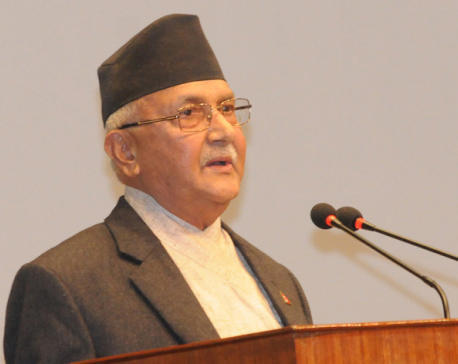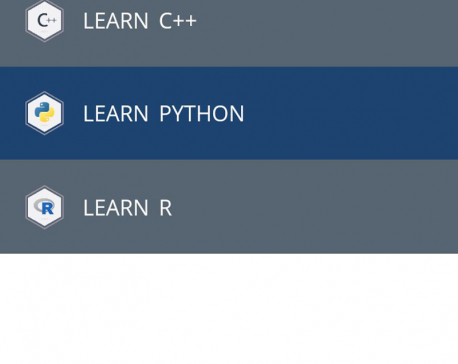
OR

More from Author
In Nepal, we are not offering students enough focused practice opportunities, and most of our feedback is either non-existent or simply irrelevant
Every Tuesdays and Thursdays, I go to a Stanford classroom inside Jordan Hall, the same hall where the classic Stanford Prison Experiment took place more than four decades ago. But I am not taking psychology lesson. It is a lesson on learning and teaching science, taught by Carl Wieman, a 2001 Nobel Laureate in Physics. Carl is now more active in research aiming to improve science education, and was recognized as one of the recipients of 2017 World Innovation Summit for Education Award for his efforts to tackle global education challenges.
This class has two main learning goals: recognizing existing challenges in science teaching and thinking of the best possible ways to address those challenges. For that, we take a course that was taught to us in the past as an example, and critique on things the teacher of that course did or did not do right. We also get chances to slowly develop activities, syllabus, assignments that could resolve those problems and facilitate better learning. The class is quite informal, mostly involving discussions among peers, and Carl is there mostly acting as a moderator. Every class day, he comes with the same curiosity and enthusiasm to hear our ideas, and we are equally intrigued to hear him. This article comes out of the knowledge I have gained in and outside of this class to analyze some common challenges in Nepali education system.
Learning curve
Learning is a dynamic process and successful learning requires enough prior knowledge, efficient knowledge organization skills, a strong motivation to learn, adequate opportunities for practice, and prompt feedback. Some of the biggest challenges in our system relate to these: Failure to gauge the prior knowledge of our students, inefficacy to keep all students motivated, lack of enough practice opportunities, and inadequacy of timely and relevant feedback. Almost all schools face these problems.
Each student arrives in a classroom with unique culture and background. Their pre-existing knowledge, beliefs and attitude determine how much they will learn. Most of our school teachers’ attempt at understanding importance of diversity is either nonexistent or perfunctory, which leads to uneven learning: Good students tend to become better and underprepared tend to fall even lower in their accomplishments. So, how do we make classroom learning more even?
Some schools have implemented ability grouping, wherein students with similar abilities are grouped together in the same classes. This seems like a good idea. After all, teachers can now deliver their materials knowing the level of their students’ knowledge. On the other hand, ability grouping could damage the self-esteem of underperforming students. Teachers’ low expectations for this underperforming group can lead to a lower quality teaching, thereby creating a vicious cycle of underperformance. Students’ learning is also shaped by their peers, so strict ability grouping deprives lower performing students of the opportunity to interact with higher performing peers, thereby effectively creating greater socioeconomic and academic stratification.
Perhaps, a better way to address this issue would be to more precisely understand the prior knowledge of students by assessing their skills in a low-stakes environment. They should be told that such an assessment is intended not to grade or judge them, but only to understand their learning modes precisely and develop techniques to help them learn successfully. Students who are assessed and found to not have enough prior knowledge should then be offered focused extra help both in and outside of the classroom, perhaps even with the help of their parents.
Another important challenge for teaching is the ability to motivate students to learn a subject. Motivation is one of the most important factors when determining students’ enthusiasm, persistence, attentiveness, and their learning behavior. Our schools too often fail to explain to students why the material they are being taught is important. More than a decade ago, when I was a student in Nepal, I used to ask what is the point of studying Sanskrit and Social Science for those subjects were neither very interesting nor practically important to me. Like most other Nepali students, I took Social Science for more than eight years, but I do not recall any teacher convincingly explaining why it was important. This could have been one of the reasons I became a consistently mediocre social science student.
Fixing problems
My experience is just one example of what the teaching in Nepal currently lacks, and why we must fix this issue by constantly reminding all students of the positive and practical values of what they are told to gain from every class. However, motivating students to learn any subject is not an easy task, as different students will have different priorities. For instance, it is much easier to motivate a student who wants to be a doctor to learn biology, while that same motivation might not work well for the student who wants to be an engineer. Therefore, teachers must be proactive in understanding their students’ individual priorities, so no student is left with a negative motivational crisis that can then become a learning crisis.
Finally, another prime challenge is to give students adequate opportunities to practice key skills taught to them. Learning thrives when students are given ample opportunities to practice their skills. That practice must be coupled with timely and relevant feedback that communicates well with students on the aspects of their work in terms of accomplishing the main learning goals of each class.
In Nepal, we are not offering students enough focused practice opportunities, and most of our feedback is either non-existent or simply irrelevant for the personal learning goals of far too many students. Students in schools take English language class, and one of its important component is writing essays. But they do not get enough assignment opportunities to write essays, and even when they are asked to write one, teachers usually do not offer feedback on writing. Consequently, the quality of students’ writing does not show significant improvement over the years. One way to address this issue as a teacher would be to give specific feedback and ask students to rewrite the essay. This technique is called deliberate practice, and research has shown that it leads to a high level of learning performance.
Another compelling example of how insufficiency of practice and feedback can impair learning comes from the sudden decline in the performance of students transitioning from grade 10 to 11. In the school leaving certificate (SLC) exam of 2014, about 120,000 students passed with first division or more, and it is reasonable to assume that most of these students chose to study science in grade 11. However, only about 50 percent of those students passed grade final exams. Among many possible factors for this decline in performance is the lack of practice opportunities and relevant feedback.
Most of the challenges mentioned above involve cognitive aspects of learning, and they are by no means exhaustive. Tackling these challenges is another challenge in itself, but as is often said the first step towards solving a problem is understanding the problem itself.
The author is a PhD fellow in Physics at Stanford University
dnshkandel@gmail.com
You May Like This

Opportunities and challenges galore as Oli returns
KATHMANDU: Firebrand leader KP Sharma Oli is back at the helm of affairs in Singha Durbar, two years after he... Read More...

Programiz: a Nepali website teaching programming to million students worldwide
KATHMANDU, Feb 22: Programiz.com is a programming tutorials website aimed at beginners. The company has tutorials on four programming languages: C,... Read More...

Challenges of curbing vehicle emissions
Basanta Adhikari, director and spokesperson of the Department of Transport Management (DoTM) shares his dream for his department. He wishes... Read More...








Just In
- Govt receives 1,658 proposals for startup loans; Minimum of 50 points required for eligibility
- Unified Socialist leader Sodari appointed Sudurpaschim CM
- One Nepali dies in UAE flood
- Madhesh Province CM Yadav expands cabinet
- 12-hour OPD service at Damauli Hospital from Thursday
- Lawmaker Dr Sharma provides Rs 2 million to children's hospital
- BFIs' lending to private sector increases by only 4.3 percent to Rs 5.087 trillion in first eight months of current FY
- NEPSE nosedives 19.56 points; daily turnover falls to Rs 2.09 billion












Leave A Comment